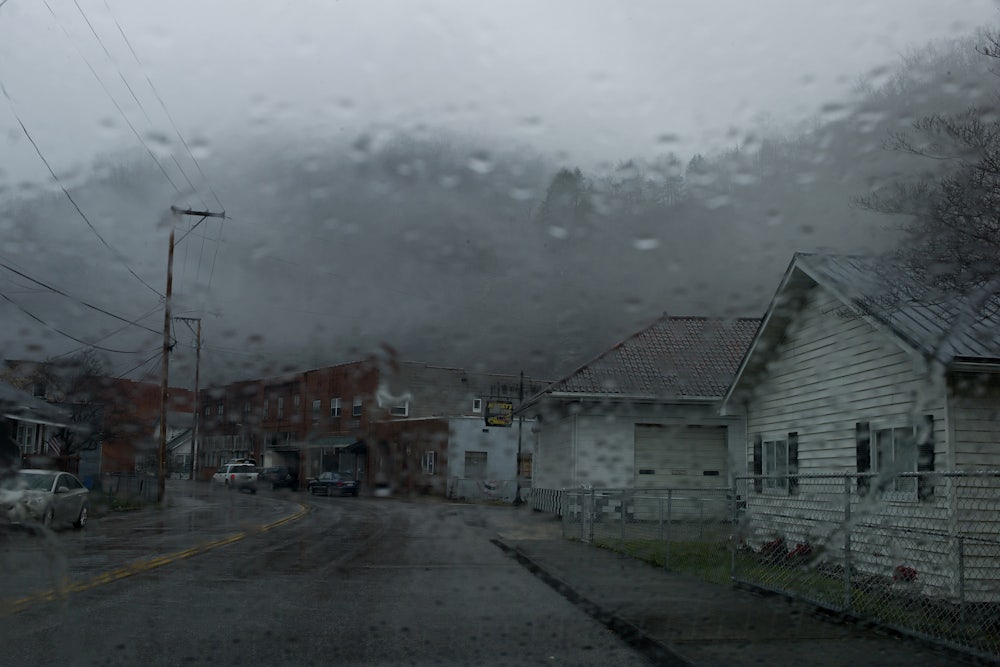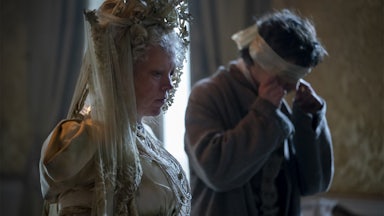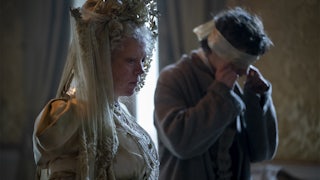In the lead-up to—and aftermath of—the 2016 election, Appalachia became a subject of fascination for a certain type of journalist who believed there they could unearth the hidden motivations of white working-class, rural voters who backed Donald Trump. The hand-wringing articles that resulted built up Appalachian Trump voters as bogeymen: angry, disaffected, “dangerous idiots” willing to vote against their own best interests. In the process, purported hillbilly whisperers like J.D. Vance were all too happy to air their dubious claims about societal decay to credulous liberals. Writing that addresses the divide between “Trump Country” and “coastal elites” is often a recipe for pat moralizing, bound to end in sentimental reconciliation.
On the surface, Idra Novey’s novel Take What You Need, which follows an estranged onetime stepmother and stepdaughter, might appear to fit this genre. Jean has lived all of her sixtysomething years in Sevlick, a fictional small town nestled in the southern Allegheny mountains of western Pennsylvania that has only grown more run-down and insular over time. Sevlick has become an exemplar of forgotten Northern Appalachia, emptied of industry and commerce, where all that remains is abandoned homes with smashed windows and a handful of old-timers with garage signs that read “Due to the High Price of Ammunition, Trespassers Should Not Expect Warning Shots.”

Jean’s stepdaughter, Leah, meanwhile, has comfortably severed herself from her rural roots. She and her father left Sevlick a few years after he and Jean bitterly divorced when Leah was 10, and she’s only intermittently connected with Jean over the years: “I’ve gone through phases of calling her up, seeking her contrarian take on things. Just as often, it’s felt saner to stop all contact.” In her thirties, Leah has carved out an intellectual, worldly life in New York City, where she lives with her Peruvian linguist husband and their bilingual toddler and works as a web editor and translator.
This could be the start to a story about a family torn apart by
Fox News, but Novey upends familiar platitudes on our country’s divisions in an
odd novel about the ways that the people and places we love can become enigmas
to us, and the ineffable impulse to make art. In Jean, Novey has crafted a
character who refuses easy categorization. Jean may have never left Sevlick,
but she’s not like her gun-toting neighbors—after decades of reading Artforum
in hiding, she finally gives in to her artistic desires in her sixties, quoting
Agnes Martin and Louise Bourgeois to herself as she welds metal sculptures she
calls Manglements. And Novey takes reconciliation off the table: At the outset
of Take What You Need, Leah—who hasn’t spoken to her stepmother in four
years—learns that Jean has died in a manner befitting a fairy tale. She slipped
off a ladder while welding, bequeathing Leah a living room full of Manglements.
As Leah travels to Sevlick to claim her inheritance, the novel shifts between
Leah’s perspective and Jean’s in the years leading up to her death, unraveling
how their mutual misconceptions of their town and each other cemented their
distance.
Part of what sets Take What You Need apart is that Novey is no tourist visiting Appalachia to gawk at its remaining residents. While her prior novels focused on far-flung locales—her debut, Ways to Disappear, followed a translator searching for a missing Brazilian Jewish writer in Rio de Janeiro; her follow-up, Those Who Knew, takes place on a fictional island after the collapse of a U.S.-backed regime—Take What You Need cuts much closer to home. Novey was raised in the same slice of the Rust Belt where she situates Sevlick, in Johnstown, Pennsylvania, a city once buoyed by iron, coal, and steel that has been economically depressed and sloughing off residents for decades. She still claims Appalachia as her ancestral home—her mother is third-generation Appalachian, and her great-grandfather started a scrap-metal recycling business that has been operating for more than a century. Aside from that scrapyard’s cameo—here, it’s Jean’s family’s place, where she gets sheet metal for her sculptures—and the fact that like Leah, Novey is a translator, Take What You Need moves beyond her biography.
Though Sevlick and its reactionary politics initially seem the source of Leah’s and Jean’s silence, as the novel progresses, Novey delves past this more obvious conflict to mine deeper sources of estrangement. Even as Leah grows more vigilant on the drive to Sevlick with every political flag and red hat she sees—though Novey never uses his name, we’re in the Trump years here—she struggles with her impulse to write off the Rust Belt. She recalls with guilt her recent quip at a party that “social progress in this country would happen much faster once everyone in those failing towns who was white and over the age of sixty had died.”
After all, Jean fell into that category. While she never left Sevlick, which she had “stuck to like a tick on a dog,” she always felt like an outsider there—as a child, she was the only Jewish kid in town and was taunted to “show [her] horns.” She holds herself at a remove from the place, her attitude not one of condescension but a cantankerous preference to be left alone with her art. Her opening lines capture her singular spirt: “I’d had it with the new mailman. He kept peering in at me through the screen door like I was up to something indecent, sculpting cocks like Louise Bourgeois. I didn’t have the forging equipment to weld anything cock-shaped.”
But in focusing solely on her art, Jean ignores signs of the town’s more extreme political leanings as Trump ascends. She fails to wake up to what Leah sees as the blatant white supremacy rising up around her until well after she and Leah have stopped communicating. “It was a shock to hear so much talk all of a sudden about what had gone over as normal here, the expectation to just put up with people’s bigotry like you do a flare of pain in your skull, hoping it’ll go away, isn’t the tumor that will keep on getting bigger till you can’t remember you own name,” Novey writes. This is what Jean is willing to bear by inexplicably remaining in the place of her birth, and what Leah cannot tolerate.
Jean’s art is evidence of her own inheritance, Appalachia’s dead steel industry, and her outsider attitude. She learned her craft in part by watching her father, a metalworker who “rarely left the garage and was too hotheaded to hold a real job”; the workbench and welder she uses to construct her Manglements were once his. “I got your tools now, bastard,” she scrawls in red paint on one of her sculptures. The discarded steel Jean repurposes in her attempts to “master the nature of a box” as she welds together tower after tower in her dead parents’ living room “was adding up in here, pulsing with something” for her, pushing her to take the Manglements to new heights. She is determined to dedicate the remainder of her life to indulging her own creativity after spending too many years working a job she never wanted at the now-defunct county hospital and bending to her own father and Leah’s father. Both men regarded her with scorn as they tended the heat of their anger.
Part of Jean’s drive to make art clearly comes from a need to work through her past. Jean takes her biggest inspiration and encouragement from Bourgeois, from whom Novey also takes her epigraph: “Every day you have to abandon your past or accept it, and then, if you cannot accept it, you become a sculptor.” Or, as translated through Jean: “Sculpture is an exorcism … it’s a goddamn exorcism, and you know what? You can’t stop halfway through an exorcism.” But for Jean, sculpture is also an opportunity to allow the mind to play for its own sake, and the scenes where Novey explores this side of creativity are some of the novel’s most electric.
The only person Jean imagines as an audience for her Manglements is Leah, who doesn’t even learn that Jean was a sculptor until after her death. As Leah tries to make sense of her loss of this “complicated person,” she finds herself falling back on Grimms’ fairy tales, which they once read together. As she approaches Jean’s house, she remembers their mutual love for the “horror” of the story “The Robber Bridegroom,” in which an “eerie old woman” bears witness to a murderous melee but doesn’t try to escape:
Although it’s only now, with Jean dead … that it strikes me as curious that the tale provides no explanation for what keeps the old woman from attempting to leave, what compels her to stay there, coexisting with a pack of murderers.… And the tale … doesn’t address what happens to the young bride after she escapes, whether she feels any pull to return to that grim house.
At the heart of Leah and Jean’s story lies this inability of each woman to understand why one cannot leave and the other must. They both feel abandoned, left behind.
“We don’t always get to find out what happens to people, or who they really are,” Novey writes toward the end of Take What You Need. Grappling with the mysteries we present to one another, Novey pushes back against the fairy tales we’ve told ourselves about polarizing places like Appalachia, spinning a far more artful story.






